The Positive Effect of Digital Tech on the Planet

As we approach another Earth Day, let’s look at all the good that digital technologies have done for the planet. From websites and apps to unique features built into each, designers and developers have an important role to play in sustainability.
On April 22, we celebrate Earth Day. This annual holiday is marked by various events that call attention to the health of the planet (as well as ourselves) and what we can do as a global society to clean it up.
Reducing environmental waste. Lowering our carbon footprint. Reducing CO2 emissions. Preventing deforestation. Investing in more sustainable practices.
Rather than rehash the same green living tips you’re going to get everywhere else for Earth Day, I want to spend today looking at all the good things that come from adopting digital technologies and, specifically, everything that designers and developers have a hand in bringing to life.
15 Types of Digital Tech That Help Clean Up the Planet
From the websites and apps you build to the choices you make for each, you may be surprised to see how much of a positive impact your work really has on the planet.
1. Ecommerce Websites and Apps
A study done last year by Generation Investment Management compared greenhouse gas emissions between online shopping and brick-and-mortar visits. On average, it found that ecommerce shopping is 17% more carbon efficient than retail shopping.
Here’s the breakdown that shows how that happens:
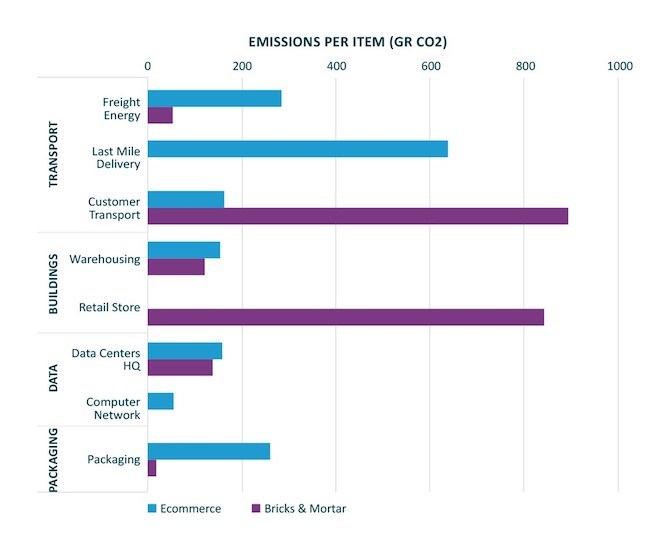
As you can see, it’s the retail property and customer transport, in particular, that make brick-and-mortar shopping the more environmentally unfriendly option. If you take those out of the equation, the roles could easily be reversed.
However, there are a number of features that will definitely help keep ecommerce green.
2. Omnichannel Shopping
Generation’s report took a look at the broad spectrum of ecommerce emissions. The graphic below demonstrates its “heaven” and “hell” scenario:
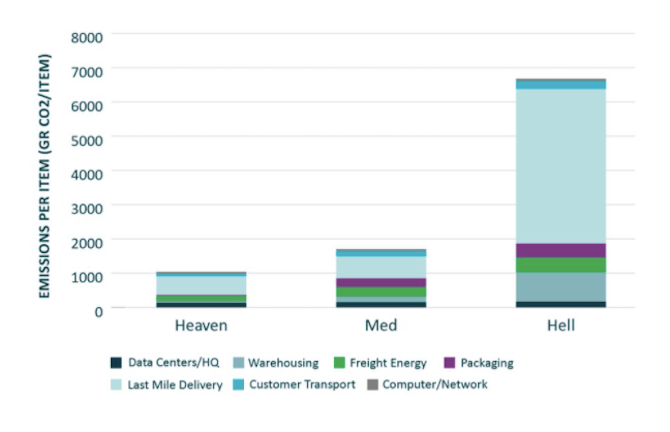
There are two factors that can make ecommerce emissions incredibly high:
- Warehousing
- Last-mile delivery
As you can imagine, this is probably a common scenario for small, independent ecommerce stores that don’t have the ability to store their inventory on site or close to their customers. Unfortunately, there’s not a lot that can be done with regards to that scenario.
Larger e-tailers that offer BOPIS (Buy Online, Pick up In Store) options, on the other hand, have the ability to reduce the warehousing and last-mile delivery environmental costs further by encouraging customers to buy items from in-store stock. Or to return online items to their local store.
3. AR/VR
Another reason why some people are wary about ecommerce’s eco-friendliness is because of the increased number of returns that come with it. And with those increased returns, that means double the transportation costs and increased environmental waste from unusable packaging.
While recent data is hard to track down on the number of returns made each year, Shopify has a solid roundup of stats that show the staggering differences between ecommerce and retail:
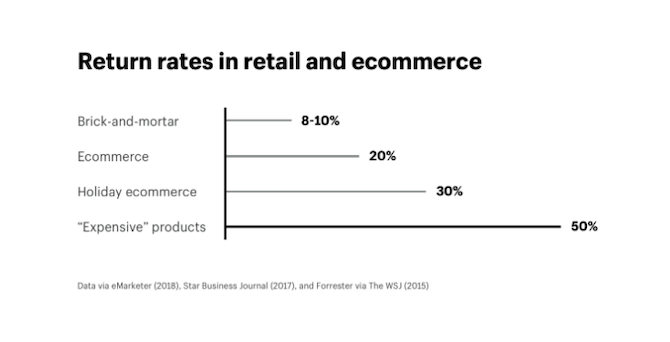
It makes sense why ecommerce shopping has such a high rate of return. That is, when augmented and virtual realities aren’t offered.
These technologies allow shoppers to make better buying decisions from the comfort of their homes, which reduces the number of returns. So, this is going to be a critical feature for ecommerce companies that want to go green in the future.
4. Digital Receipts
According to Green America, paper receipts are really bad for the planet as well as its people:
- 93% of paper receipts get coated with BPA or BPS. Retail employees who handle them regularly have 30% more BPA or BPS found in their bodies than consumers.
- In the U.S., it takes more than 3 million trees and 9 billion gallons of water to create receipts every year. And most paper receipts are not recyclable.
- Paper receipt production also emits 4 billion pounds of CO2 in the U.S.
By including a digital receipt option either in retail POS systems or during ecommerce checkout, you can reduce the waste caused by paper receipts or package inserts. As well as the ridiculous social media memes about the size of receipts:

5. Online Forms
Anyone else remember the days when you’d be lost without a notepad and pen on your desk? I remember filling notebook after notebook with notes from calls with prospects or while onboarding clients.
Thankfully, online forms not only save us the trouble having to document our conversations by hand, they also reduce all the paper waste we were creating before.
And it’s not just for use cases like the one I mentioned above. Think about online applications for jobs. It used to be that you’d print out or pick up a paper application and fill it out. Now, you just do it all online.
The same goes for online forms that collect info prior to appointments—like when you go to a new doctor or you book a spa day.
By building forms into websites and apps, not only do you allow businesses to depend less on paper, but you create more convenient solutions for their customers and clients, too.
6. Paperless Invoicing and Billing
Similar to the benefits of digital receipts, paperless invoicing and billing allows you to request money and receive reminders to make payments digitally.
In addition to reducing paper consumption, paperless invoicing comes with other benefits, like cost reduction. Businesses can also improve efficiency (which means less time working and online) by using templates and automating the preparation and sending of invoices each month.
7. Big Data
Big data isn’t just valuable for companies. When you provide customers with data about their usage, you empower them to make healthier choices.
One way to do this is to add time limit settings to social and gaming apps. Obviously, that’ll be a good thing for users. In addition, as people become more mindful of how much time they spend online, they’ll consume less electricity and wifi which is, in turn, better for the environment.
Another way big data helps the environment is through usage monitoring.
For instance, my former utilities provider had a portal I could use to monitor my usage of electricity and water in my apartment. It looked similar to the one I currently use to track my data usage from Cox Communications:
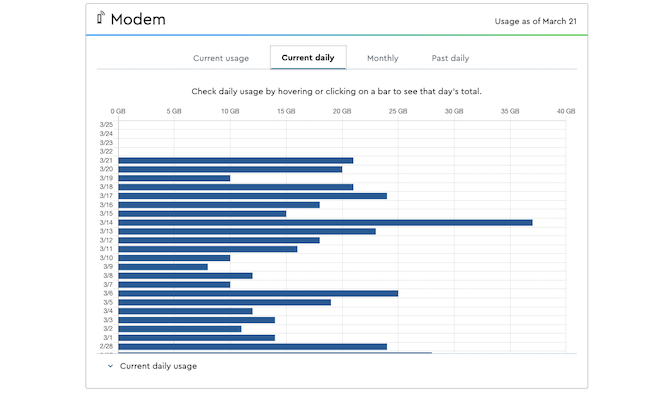
Having access to this kind of data makes consumers more mindful of what they’re using. User dashboards that include extra incentives—like discounts on bills for lowering usage during peak periods—is also helpful in creating better habits.
8. Online Newspapers and Magazines
Back in 2007, I worked for a newspaper in Boston. At the time, everyone was talking about the death of print and how we all needed to look for new jobs.
Considering how much paper was getting thrown away every day—either because of misprints or because people just weren’t reading newspapers anymore—we were right to worry about its demise. We were just off by about 10 years:

As more newspapers and magazines transition to a 100% digital strategy, and social media picks up some of the slack, we’re going to see these print numbers drop even more. This’ll help stop some of the deforestation done for the sake of printing paper.
9. CRMs and Other Digital Data Storage
Way, way back in 1998, I got a job working as an assistant at an accounting firm. By assistant, of course, I mean I handled their filing.
They’d give me all of their paperwork along with carbon copies of each piece of paper and have me file it alphabetically in giant drawers. It would take me anywhere from 5 to 20 minutes to find the right drawer, file within that drawer and spot within that file to slot the record into the right place. So, yeah, it was a lot of paper.
I can’t even imagine what happened when that office digitized a decade or so later. After they threw out all those printed records and copies of each record, what did they do with all that extra space?
That’s actually something to think about when it comes to the digitized storage of data in CRMs and other business apps. Because it’s not just about removing that cycle of deforestation and environmental waste when you print so much paper. When you get rid of printed records, you get rid of the need for so much physical storage and space. Businesses that scale back can actually reduce their individual carbon footprint that way.
10. AI and Automation
The International Institute for Sustainable Development warns that automation technologies could be a double-edged sword when it comes to the environment.

Obviously, increasing use of electricity when moving toward automation can raise the risk of greenhouse gases. So, in order to reap the benefits, the rest of our technologies and practices would need to go greener as well (which is really what this whole post is about).
But let’s assume the best case here. Think about what AI and the IoT do for businesses and consumers alike right now.
For instance, they improve efficiency, which means less wasteful actions. They also help people make more informed choices, which cuts down on bad practices and mistakes. If we build smarter and stronger products, automation really could be a game-changer for the environment.
11. Digital Communication Apps
There are a lot of studies that came out in 2020 studying the relationship between pandemic lockdowns and the environment.
Here’s what a study from Shefali Arora, Kanchan Deoli Bhaukhandi and Pankaj Kumar Mishra reveals about the change in pollutants before and after lockdown:
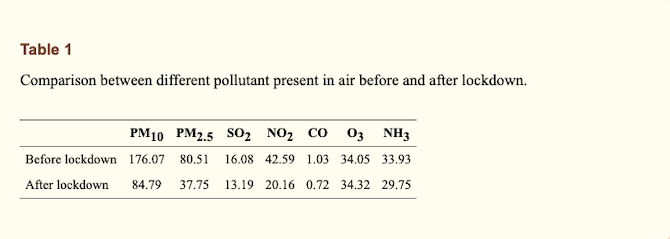
Thanks to the pervasive adoption of digital communication tech like Zoom and Slack, everyone could pause their work-related travel plans with little impact on efficiency or efficacy.
There was once a time when it was unheard of to do interviews, meet clients, attend company meetings or go to professional conferences online.
But as we’ve all seen during the pandemic, that’s no longer the case. Everything really can be done online. Just look at Zoom’s stock in 2020. It peaked at 817% growth and then settled for a still insanely impressive 425% by the end of the year.
12. Collaboration Features
Think about how much time it might take you to work something out with a colleague or to get approval from a client if collaboration weren’t built into your business software. I’m sure you’ve been in that boat before and it’s never good.
You email. You message. You call. You wait. And then the game of telephone starts. The more time the two of you spend trying to get on the same page, the more energy you consume.
Thankfully, collaboration is now built into so many business apps. By removing the barriers to collaboration, companies can stop wasting so much time and energy.
As an added bonus, digital collaboration products allow businesses to work with the best of the best from around the world. There’s no need to rent office space, hire local talent and contribute to higher emissions. Everyone works from home and works together as seamlessly as they would in person.
13. (Local) SEO
According to Sustainable Connections, consumers who live in areas with a lot of local businesses drive 26 fewer miles than those who don’t.
It’s not just consumer automobile pollution that gets reduced. Buying from local companies can also reduce the mileage required to get products from warehouses on the other side of the country or the world out to consumers.
In addition, buying locally helps reduce habitat loss. Specifically, it helps farmers stay in business and prevents developers from snagging up land and turning it into resource-hogging commercial centers.
And this is why I’d argue that SEO—especially local SEO—is such a valuable tool in the fight to protect the environment. While people can certainly go out and explore their local communities on their own, they’re going to learn about many more local offerings with the help of search engine results.
14. Sharing Economy Apps
A paper published by Zhifu Mi & D’Maris Coffman in Nature details the environmental benefits of the sharing economy. It’s not a given, of course, but if these companies and their users adhere to the right practices, it could be really good for the planet.
Take ride-sharing apps, for example. By reducing the number of vehicles on the road, these apps help reduce pollution and emissions.
Or how about bike- or scooter-sharing apps? By making it easier for people to find and use bikes or scooters when they actually need them, these apps get even more cars off the road.
Even something like Airbnb can be environmentally friendly. By staying in someone’s existing home, there’s less of a need for developers to build more hotel properties which allows us to preserve more land and habitats—for a little while longer anyway.
15. Ethically Designed Apps and Websites
Last but not least, we have ethically designed websites and apps. Why do I include these on the list? After all, ethical design choices are supposed to help the users, right?
If you think about it, many of the side effects of ethical design help the environment, too.
Time limits and reminders are, of course, one way in which ethical design can make an app more eco-friendly. Creating less addictive designs as a whole is useful for this as well.
Smaller, faster loading websites built on green hosting are also really important for reducing a company’s carbon footprint. According to the Web Neutral Project:
“An average sized site will emit 4,700 pounds of CO2e in a year. According to the EPA, that is equivalent to consuming 240 gallons of gasoline.”
Wrap-up
Digital technologies have certainly had a huge impact on the way we live our lives and run our businesses. But, as it turns out, digital tech—and, specifically, the technologies you have a hand in building—are doing a lot of good for the health of this planet, too.

Suzanne Scacca
A former project manager and web design agency manager, Suzanne Scacca now writes about the changing landscape of design, development and software.
